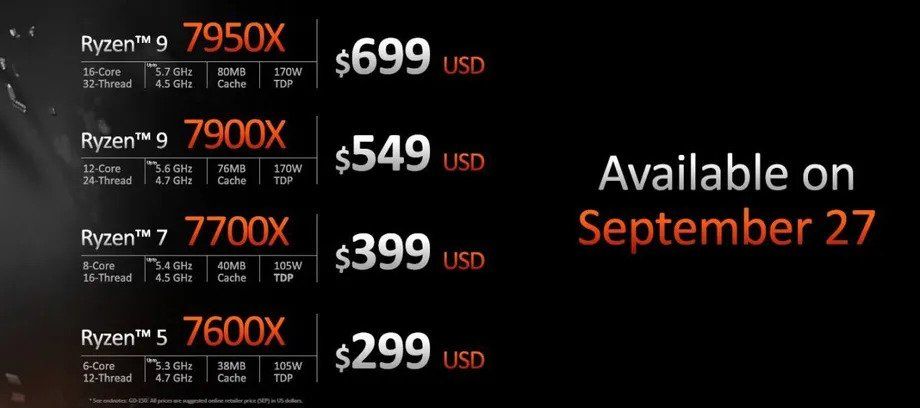Last night, a new generation of computer processing unit by AMD has been revealed and the Ryzen Zen 4 family is official and this is what you can expect if you are in the market for upgrading or building a new PC.
AMD CEO Lisa Su presented during AMD's even "together we advance_PCs", the new Ryzen Zen 4 family is the firsts SoCs reaching at 5nm manufacturing process, which will mean that it is consuming less energy and be equal or a bit more powerful than its predecessor Zen 3, that was manufactured on 7nm process.
While those of you that keep tracking on specs, you will notice that in terms of clock speed, appears n much improvement, but, when there is a need for computing power, the frequency can get as high as 5.7GHz with up to 13% improvement in IPC from the new Zen 4 microarchitecture.
That results in a 29% improvement in single-threaded performance over the prior-gen chips. That higher performance also extends out to threaded workloads, with AMD claiming up to 45% more performance in more demanding applications.
This is the first generation with full support for the AM5 socket and no, AM4 will not be compatible so this is a first thing to keep in mind of you are upgrading, as a new Motherboard is not out of the question in any ways but the upside is that you are already ready for DDR5 lanes and while DDR 5 RAM are still a little pricey which is the first of the downside and secondly, the Zen 4's full potential does requires DDR5 RAM.

Of course the main offering are the Ryzen 9 7950X which features 16 cores, 32 threads, and a boost clock of up to 5.7GHz and the 7900X that features 12 cores, 24 threads and a 5.6GHz boost and this is for power user working in marketing and entertainment productions, premium content or have to squeeze everything out of a video game.
Now keep in mind that the jump of TDP are from almost 65 watts as the TDP is marked as 170 watts of consumption and the only hope that this generation doesn become a power hungry heavyweights, almost crossing the line of a PC turning on a intelligent microwave is that GPU maintains control on energy and temperature.
One can hope, right?
Following in descendant order is the Ryzen 7 7700X, featuring 8 cores, 16 threads and a 5.3GHz boost and finally the Ryzen 5 7600X with 6 cores, 12 threads and a 5.3 GHz boost.
AMD confirmed that in general, the Zen 4 family can achieve 13 Instructions per cycle over the Zen 3 family.
Finally and a big improvement is that for gaming at 1080p, you will be NOT in the immediate need for a GPU as the Zen 4 architecture includes a built-in RDNA2 chip including 2 graphics cores, each with 64 stream processors, with a boost clock of up to 2.2GHz, but AMD recommend the usage for content creation and simple output of display.
Finally and regarding the past generation of AM4 socket, Lisa Su confirmed that AM4 will still be supported and for the time being, both AM4 and AM5 will be coexisting and this is an obvious AMD answer to the challenges that the semiconductors shortage is keeping affecting all industries around the world.
The Zen 4 Ryzen family will be released on September 29th and cost will vary depending models with Ryzen 9 7950X at $699, 9 7900X at $549, 7 7700X at $399 and 5 7600X at $299 and it is slated that Motherboard with AM5 will start at $150.
Unfortunately and VERY DIFFERENT from last time, AMD did not offered gaming related benchmarking but, probably they are saving it for the Radeon RDNA 3 presentation, slated to later this year.

